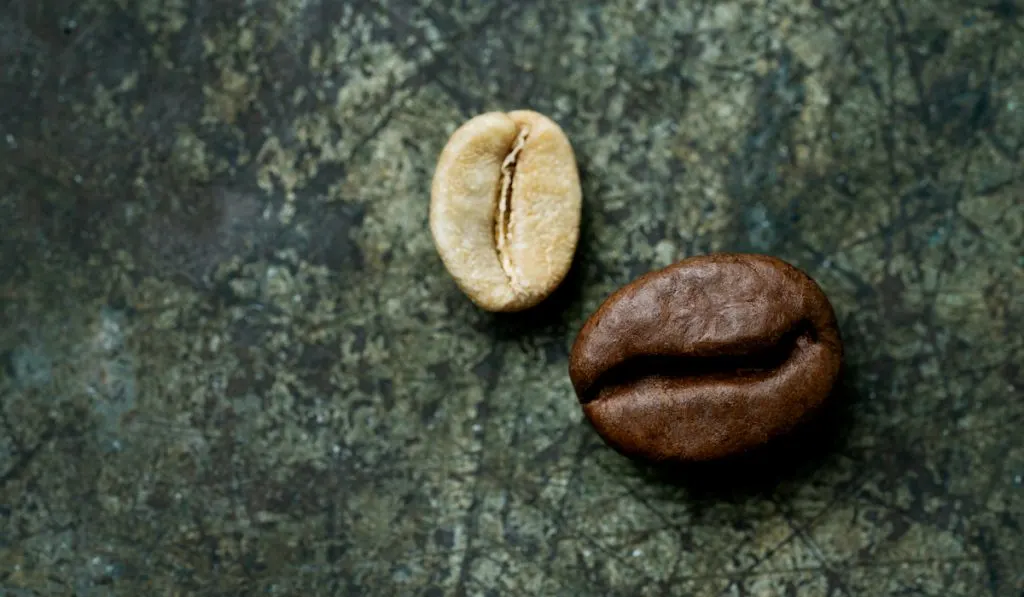In many cases, people choose to buy roasted coffee beans for obvious reasons. Buying pre-roasted coffee beans saves time and is less stressful since you do not have to do the roasting.
But then there are cases where people prefer to buy unroasted coffee beans over roasted ones.
You might be wondering why anyone would want to go through the stress of roasting coffee beans at home instead of getting already roasted beans. Well, the answer to this lies in the differences between roasted and unroasted coffee beans.

Differences Between Roasted and Unroasted Coffee Beans
Freshness
The flavors and essential oils in roasted coffee beans do not stay forever; they leak and start to fade away with time. Of course, when this happens, coffee will not taste as fresh as it can be.
The freshest coffees are prepared from freshly roasted coffee beans. But the chances of getting newly roasted coffee beans when you go shopping are almost zero. So, coffees made from roasted coffee beans are typically not as fresh as they can be.
When you get unroasted coffee beans, you can roast them at home and use them to make coffee in their most flavorful form.
So, between roasted coffee beans and unroasted coffee beans, the unroasted ones can help you achieve higher freshness.
Price
While both roasted and unroasted coffee beans can be pretty affordable, the unroasted types are usually cheaper. This price difference is logical; the labor and time that go into roasting add to the overall cost of production. Then, the cost of production is reflected in the selling price.
With unroasted coffee beans, the manufacturer does not spend labor, time, or money on roasting. So, the production cost is less than that of roasted coffee beans. Hence, the lower selling price.
Note that when unroasted coffee beans seem too cheap, you may be buying a batch that has been around for up to 2 years. Conversely, high-quality green coffee beans are typically more expensive than the average price.
While green coffee beans are relatively less expensive, you may incur extra costs in buying your own coffee grinding machine and coffee roaster.
If you choose not to get a roaster and a grinding machine, you can visit a coffee shop to get your coffee beans roasted and ground. This service will not be free of charge. When you calculate the costs, you may just be better off getting your own roaster and grinder.
Flexibility
Unroasted coffee beans give you some flexibility that does not come with roasted coffee beans. For one, you can try out various coffee roasts with unroasted coffee beans.
Besides making various types of roasts, you can use unroasted coffee beans for many other purposes, including medicinal uses.
With roasted coffee beans, you do not get the same flexibility as green coffee beans. Besides making coffee, there isn’t much you can do with them.

Shelf-Life
In the absence of roasting, coffee beans have a long shelf-life. This makes sense since the roasting process may destroy certain compounds that conserve the freshness of the beans.
Generally, unroasted coffee beans have an average shelf-life of around 12 months when properly stored. Roasted coffee beans, on the other hand, typically have an average shelf-life of 1 month. Within a day, roasted beans may have lost up to 40% of their flavor.
Many recommendations state that you should only buy roasted coffee beans you intend to use within a short period – typically a day.
Also, if you intend to get roasted coffee beans, ensure your coffee storage is good enough or the beans will lose quality within a short period.
Going by the above, if you want to stock up on large quantities of coffee beans, green/unroasted coffee beans are the better option. With their longer average shelf-life, you can store them and use them at will.
Aroma/Flavors
Ordinarily, unroasted coffee beans have little or no aroma. But when you finally roast them and make them into coffee, they offer rich flavors and aromas.
Roasted coffee beans, on the other hand, lose flavor over time. So, if they stay too long without being brewed, they will make less flavorful coffee when eventually used.
When you buy green coffee beans, you get the chance to add your own external flavors after roasting. Roasted coffee beans, on the other hand, will come with pre-added flavors.

Color
Another difference between roasted and unroasted coffee beans is their colors. While unroasted coffee beans are green, roasted coffee beans can be anywhere between light and dark brown.
Acidity
Compared to roasted beans, unroasted beans are highly acidic. Roasted coffee beans, on the other hand, have lower levels of acid. This applies because the roasting process draws out most of the acid in the unprocessed beans.
Taste
Unroasted coffee beans are not pleasant to taste. They are described as being bitter, grassy, woody, and acidic. Of course, these all change when they are roasted.
Roasted coffee beans, on the other hand, are more pleasant on the tongue. They have a complex taste, which is typically caramel-like, nutty, flowery, and smoky. If roasted excessively, coffee beans may become bitter.
Processing Time
It goes without saying, but unroasted coffee beans have longer processing times than roasted coffee beans. This applies because you have to roast the coffee beans then grind them before you can make coffee.
With roasted beans, all you may need to do is grind the beans before making coffee. Then again, in some cases, the beans are already ground, so all you need to do is brew.
Roasted vs. Unroasted Coffee Beans (The Differences)
| Unroasted Coffee Beans | Roasted Coffee Beans | |
| Taste | Unroasted coffee beans are typically bitter and acidic to taste. They may also be woody and grassy. | Roasted coffee beans are typically nutty, flowery, caramel-like, and smoky. |
| Freshness | They offer more freshness since they can be roasted immediately before brewing. | Typically not as fresh because after roasting, coffee beans lose their flavor and essential oils over time. |
| Price | Typically less expensive than roasted coffee beans. | Typically more expensive than unroasted coffee beans. Roasting adds to the total production cost through labor, time, resources, and much more. |
| Flexibility | More flexible since you can experiment with them. You can make different types of roasts and use them for medicinal purposes. | Roasted coffee beans are not as flexible. The type of roast you get is what you work with. Also, they are mainly used for making coffee. |
| Shelf-life | They have an average shelf-life of 12-18 months when stored properly. | They have an average shelf-life of 1 month. |
| Flavor | Unroasted coffee beans in their base form give off little or no aroma. However, coffees made from them typically have rich aromas and flavors because they are freshly brewed. Besides, you can add the flavor you want after roasting. | The flavor of coffee made from roasted beans is usually not as fresh. Following roasting, the beans lose essential oils as they sit on the shelf. Also, roasted coffee beans come with pre-added flavors, which may not be what you want. |
| Color | Green | Any color between light and dark brown. |
| Acidity | More acidic than roasted beans. | Less acidic since they lose most of the acid during roasting. |
| Processing Time | They have longer processing times since you have to roast and grind before brewing. | You may only have to grind before brewing. In some cases, you only have to brew. |
What Effect Does Roasting Have on Coffee Beans?
Many physical changes and chemical changes occur when coffee beans are roasted.
Some of the chemical changes that occur when coffee beans are roasted include the following:
- The caramelization of sugars. This process contributes to the caramel-like taste and smell of roasted coffee beans.
- Production and proliferation of volatile compounds such as essential oils. This plays a part in the flavor of the roasted beans.
- Production of melanoidins, which change the color of the beans.
- Degradation of acids such as tartaric acid and citric acid. This is why coffee loses its sweet and fruity flavor the longer it is roasted.
- Formation of acids such as quinic acid and caffeic acid from the degradation of chlorogenic acid.
Some of the physical changes seen when roasting coffee includes:
- Color change from green to brown.
- Water loss
- Reduction in bean weight
- Larger bean volume
- Increased beans porosity
- Oily bean surface

Is Home Roasting Coffee Worth It?
The answer to this depends on what you want.
Home roasting coffee is worth it under the following conditions:
- If you want a fresh, flavorful coffee with an authentic taste, home roasting is worth it.
- If you want to control the type of roast you get – light, medium, or dark – home roasting is worth it. This allows you to control the flavor, caffeine, and taste of your own coffee.
- If you would love to earn a new skill, roasting your coffee at home yourself is worth it.
Home roasting coffee may not be worth it if:
- You are short on free time.
- You are not bothered by the lower level of freshness and flavor offered by pre-roasted coffee beans.
Resources
- https://www.haymancoffee.com/blogs/coffee-blog/is-it-really-worth-roasting-green-coffee-beans-at-home
- https://www.coffeescan.com/beans/roasted-vs-unroasted-coffee-beans
- https://coffeecraftcode.com/the-differences-between-roasted-and-unroasted-coffee-beans
- https://coffeeandteacorner.com/what-is-green-coffee
- https://coffeeaffection.com/is-roasting-your-own-coffee-beans-worth-the-time-effort
- https://perfectdailygrind.com/2019/03/what-happens-during-coffee-roasting-the-chemical-changes
- https://perfectdailygrind.com/2019/03/what-happens-during-coffee-roasting-the-physical-changes
